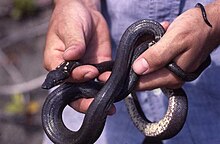| Round Island boa | |
|---|---|

| |
| Conservation status | |
 Vulnerable (IUCN 3.1) | |
| CITES Appendix I (CITES) | |
| Scientific classification | |
| Domain: | Eukaryota |
| Kingdom: | Animalia |
| Phylum: | Chordata |
| Class: | Reptilia |
| Order: | Squamata |
| Suborder: | Serpentes |
| Family: | Bolyeriidae |
| Genus: | Casarea Gray, 1842 |
| Species: | C. dussumieri |
| Binomial name | |
| Casarea dussumieri (Schlegel, 1837) | |
| Synonyms | |
|
Genus:
Species:
| |
The Round Island boa (Casarea dussumieri), also known commonly as the Round Island keel-scaled boa and the Round Island ground boa, is a species of nonvenomous snake in the monotypic genus Casarea in the family Bolyeriidae. The species is endemic to Round Island, Mauritius. No subspecies are currently recognized.
Etymology
The specific name, dussumieri, is in honor of Jean-Jacques Dussumier, a French merchant, ship owner, and collector of zoological specimens.
Description

Adults of C. dussumieri are slender and reach a maximum total length (including tail) of 150 cm (5 ft). The males have slimmer, more pointed heads and have shorter bodies than the females. The body is covered in small keeled scales that give the species one of its common names. The genus is unique among extant vertebrates as it has a split jaw (intramaxilliary joint that separates anterior and posterior bones), an adaptation that may be advantageous in catching its main prey of geckos and skinks.
The colour pattern is dark brown dorsally, the belly being lighter with dark spots. Over a 24-hour period the boa has a shift in colour, changing from "dark" during its relatively inactive day time period to "light" in the early evening through to dawn when it is most active. This effect is created through polychromatic skin cells.
Geographic range
C. dussumieri is known to survive on Round Island, but has been recorded on the islands of Gunner's Quoin, Flat Island, Ile de la Pas, and on mainland Mauritius (as subfossil remains).
The type locality is "I'île ronde, près de Maurice " (Round Island, Mauritius).
Between 11 and 31 October 2012 the boa was reintroduced into Gunner's Quoin as part of a joint collaborative project involving the Durrell Wildlife Conservation Trust, the Mauritian Wildlife Foundation, and the National Parks and Conservation Service of Mauritius.
Conservation status
The species C. dussumieri is classified as Endangered (E) on the IUCN Red List for the following criteria: D (v2.3, 1994). This means that, although it is not critically endangered, for some time it has faced a very high risk of extinction in the wild. In 1996 the population was estimated to number less than 250 mature individuals.
Recent conservation efforts have seen an increase in the number of adult Round Island boas to around 1,000. This has been achieved by eradicating goats and rabbits from the island and restoring natural habitat, which has led to an increase of the Round Island boas’ natural prey, lizards. In recent breeding efforts, Round Island boas in captivity have been fed by scenting small mice with chicken thigh meat.
Reproduction
In C. dussumieri, breeding begins during April, although young have been observed throughout the year. A clutch of up to 12 soft-shelled eggs may be laid amongst leaf litter or in hollow palm trunks, and is sometimes attended by the female. Incubation is unusually long for a snake, lasting about 90 days. The young are bright orange at birth and weigh less than 5 grams.
References
- ^ Cole, N.; Hector, A.; Roopa, P.; Mootoocurpen, R.; Goder, M. (2018). "Casarea dussumieri". IUCN Red List of Threatened Species. 2018: e.T3989A152276140. doi:10.2305/IUCN.UK.2018-2.RLTS.T3989A152276140.en. Retrieved 17 November 2021.
- "Appendices | CITES". cites.org. Retrieved 2022-01-14.
- ^ McDiarmid RW, Campbell JA, Touré TA (1999). Snake Species of the World: A Taxonomic and Geographic Reference, Volume 1. Washington, District of Columbia: Herpetologists' League. 511 pp. ISBN 1-893777-00-6 (series). ISBN 1-893777-01-4 (volume).
- ^ "Casarea dussumieri ". Integrated Taxonomic Information System. Retrieved 16 August 2007.
- "Casarea Gray, 1842". Integrated Taxonomic Information System. Retrieved 25 March 2015.
- ^ Casarea dussumieri at the Reptarium.cz Reptile Database. Accessed 25 March 2015.
- Beolens, Bo; Watkins, Michael; Grayson, Michael (2011). The Eponym Dictionary of Reptiles. Baltimore: Johns Hopkins University Press. xiii + 296 pp. ISBN 978-1-4214-0135-5. (Casarea dussumieri, p. 78).
- "Blog | Durrell Wildlife Conservation Trust".
- 1994 Categories & Criteria (version 2.3)IUCN Red List. Accessed 16 August 2007.
Further reading
- McAlpine DF (1981). "Activity Patterns of the Keel-Scaled Boa (Casarea dussumieri) at the Jersey Wildlife Preservation Trust". Dodo, Journal of the Jersey Wildlife Preservation Trust 18: 74-78.
- McAlpine DF (1983). "Correlated physiological color change and activity patterns in an Indian Ocean boa (Casarea dussumeri )". Journal of Herpetology 17: 198-201.
- Bloxam, Quentin M. C. (1984). "A preliminary report on the captive management and reproduction of the Round Island Boa, Casarea dussumieri ". pp. 155–177 In: Tolson P (Editor) (1984). Proceeding of 7th Annual Reptile Symposium on Captive Propagation and Husbandry. Thurmont, Maryland: Zoological Consortium of Maryland, Inc.
External links
- Casarea dussumieri at the Reptarium.cz Reptile Database. Accessed 16 August 2007.
- Round Island keel-scaled boa (Casarea dussumieri ) at ARKive. Accessed 18 February 2008.
- World Wildlife Fund, ed. (2001). "Mascarene forests". WildWorld Ecoregion Profile. National Geographic Society. Archived from the original on 2010-03-08. Retrieved 18 February 2008.
| Taxon identifiers | |
|---|---|
| Casarea dussumieri | |